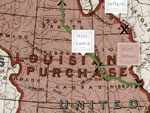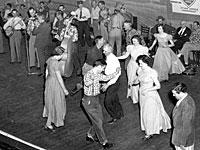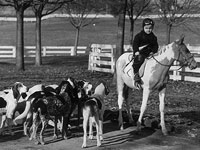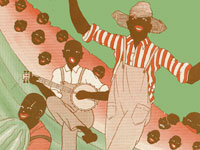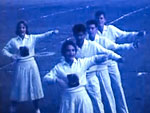Often, in my mission to include primary sources in my AP U.S. history curriculum, I find that my lessons become predictable and less awe-inspiring than I would like them to be. My students have analyzed, discussed, interpreted, and synthesized primary resources to such an extent that some of them lose sight of the fact that these items can be a lot of fun to manipulate. If your students sometimes feel the same way, why not try something a little different that still includes sound instructional techniques and content synthesis? Here is what my students and I did to fight primary-source boredom.
Finding New Ways to Engage Old Sources
After reading the chapters and completing some basic homework related to the Depression, I asked my student to find at least three separate primary sources pertaining to the Great Depression. The first needed to be an official document of some sort (government document, newspaper article, legislation, etc.); the second could be an image (cartoon, poster, photo, etc.); and the third item needed to be a personal account of some sort (diary, letter, editorial, etc.). Each of these items needed to be from the Depression period, between 1929-1938.
Once my students found their documents, I asked them to create a story that bound the three documents together. This could be total fiction or some version of historical fiction, but the story needed to not only mention each document, but explain or address its historical meaning and significance within the structure of the story. Other than these instructions, I allowed the students to apply their own creative instincts to the assignment. (Note: Previously, we had done a number of other primary source projects that required the kids to find sources on their own, so this was not the first time I'd asked them to locate content-specific primary sources. If this is your student's first exposure to primary source research, you may want to spend some extra time guiding them through Teachinghistory.org or another quality history resource venue).
[. . . S]ome of my logical-sequential students moaned at [the assignment's] right-brained nature, but a handful of kids saw it as a chance to set themselves apart from the traditional super-student who can read fast, ace every test, and answer every discussion question. . .
Upon receiving this newfangled assignment, some of my logical-sequential students moaned at its right-brained nature, but a handful of kids saw it as a chance to set themselves apart from the traditional super-student who can read fast, ace every test, and answer every discussion question first. In addition, a bunch of kids were simply relieved by the break in routine. With such a diverse reaction to the assignment, I was excited to see how this experiment would go.
The Product
The final products offered a fantastic diversity of effort, creativity, and depth of research. As always, there were a few students who just went through the motions and turned in three documents with a superficial, ill-formed story, but most of the students seemed to enjoy the departure from strict, conventional historical study. Passionate accounts of suffering, hardship, sadness, anger, hope, and overcoming obstacles arose from the images and documents they discovered. Fictional characters were created based upon contextual clues offered by the source material and plotlines evolved as my students made artistic and historical connections between each of the documents. It was fascinating to see how easy it was for my students to synthesize the information in their documents and carry it into their imagined realities.
Overall, I loved the results of the assignment. The stories were fun to read, and since we seldom have a chance to travel creative avenues in the A.P. curriculum, I think most of the kids viewed it as a welcomed break from the relentless push towards the exam in May. But what seemed like a break to them was simply another one of Mr. Gorr's hidden agendas—one of which was so hidden that I didn't even see it until I was grading their assignments. Here are my original objectives, plus the third I discovered:
The first objective of this assignment was to provide curricular diversity and a chance for my right-brainers to excel. I think we accomplished that successfully.
Evaluation and synthesis skills are essential to writing a good DBQ, and this assessment allowed us to look at these processes in a totally different way.
The second objective and my original reason for designing the lesson was to obscure the anxiety-invoking document analysis component of Document Based Question (DBQ) writing by allowing students to create their own story instead of basing everything upon documented history. This lesson still required them to evaluate and synthesize their sources, but they could do so without the restrictions they felt when confronted with DBQs. Evaluation and synthesis skills are essential to writing a good DBQ, and this assessment allowed us to look at these processes in a totally different way.
Once I related the correlations between the fictional DBQ and the actual DBQ, a number of my students seemed to have an epiphany. This assignment allowed them to see document analysis in a much more simplistic way.
Pulling Meaning from Sources v. Selecting Sources to Fit a Narrative
If historians conduct their research with a preconceived idea of what the documents will say, they can inadvertently ignore important information. . .
I discovered the third objective retroactively. After reading their stories, I noticed that some students chose documents with a story already in mind. In other words, they didn't write a story to connect their documents, they chose documents to fit their story. At first, I just saw this as a shortcut to finishing the project, but the more I thought about it, the more it emphasized the challenges that face historians when they try to relate the past to modern audiences. If historians conduct their research with a preconceived idea of what the documents will say, they can inadvertently ignore important information that could challenge the history they want to tell. In some cases, the omissions could dramatically skew the conclusions made and diminish the creditability of the author and his/her historiography.
In many ways, this objective overtook my original objectives. Since our understanding of the past is in the hands of historians (both good and bad), I think it is very important for my students to understand the interpretation that goes into writing history. We compared Christopher Browning's book Ordinary Men with Daniel Goldhagen's book Hitler's Willing Executioners. Each author wrote significantly different histories about a group of German soldiers, based upon the identical primary resources. My students were enthralled by the discussion of how important a historian's job is. For a few minutes, I was cool!
In Conclusion
In all, I was extremely pleased with all aspects of this assignment. It allowed us to verge from the beaten path and explore underused methodologies that allowed my students to expand their critical and creative thinking skills while still maintaining focus upon the core objectives of the AP curriculum.
If you have suggestions, comments, questions, etc., please let me know. More importantly, if something I have written motivates you to create something even better, please share it with me. We are all curricular thieves in teaching and in this case, my hope is that I can, as Huey Long put it, "Share the Wealth."
